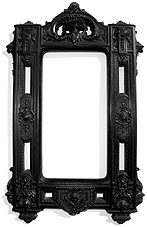Shellac
- See Shellac (band) for the post-punk band.
Shellac is a brittle or flaky secretion of the lac insect Coccus lacca, found in the forests of Assam and Thailand. Freed from wood it is called "seedlac." Once it was commonly believed that shellac was a resin obtained from the wings of a bug (order Hemiptera) found in India. In actuality, shellac was obtained from an excretion of the female bug, harvested from the bark of the trees where she deposits it to provide a sticky hold on the trunk. Unfortunately there is a risk that the harvesting process can scoop the bug up along with the secretion, leading to its death.
When purified, the chemical takes the form of yellow/ brown pellets, this possibly providing the basis for the "Wing Source Story." Shellac is a natural polymer and is chemically similar to synthetic polymers, thus it is considered a natural plastic. It can be molded by heat and pressure methods, so it is classified as thermoplastic.

It was used beginning in the mid-19th century to produce small goods like picture frames, boxes, toilet articles, jewellery, inkwells and even dental plates.
It is soluble in alkaline solutions such as ammonia, sodium borate, sodium carbonate, and sodium hydroxide, and also in various organic solvents.
When dissolved in acetone or alcohol, shellac yields a coating of superior durability and hardness and is available in numerous grades. It is used in the traditional "French polish" method of finishing furniture, and fine viols and guitars. Orange shellac is bleached with sodium hypochlorite solution to form white shellac. Because it is compatible with most other finishes, shellac is also used as a barrier or primer coat on wood to prevent the bleeding of resin or pigments into the final finish, or to prevent wood stain from blotching. Lightly tinted shellac preparations are also sold as paint primer.
As it is edible, shellac was used as a glazing agent on pills or candies. For this purpose, it has the food additive E number E904. There are concerns that, as it may contain crushed bugs, this coating is not vegetarian. In the tablet manufacture trade, it is sometimes referred to as "beetlejuice" for this reason.
Shellac was also used in the production of gramophone (phonograph) records until about 1950. See gramophone record for details.
It is now considered obsolete as a moulding compound, having very few applications.
However, it is still used as fruit coating to prevent post-harvest decay.
It is frequently used in dental technology for the production of custom impression trays.
Also used by the optical trade.
A corn protein called zein is a competitive product to shellac for some applications.
Related words
Schellack is a relatively uncommon surname.
